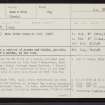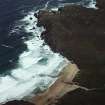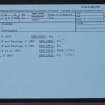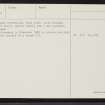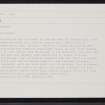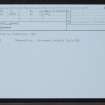Lewis, Dalmore
Settlement (Period Unassigned), Beaker (Pottery)(Bronze Age)
Site Name Lewis, Dalmore
Classification Settlement (Period Unassigned), Beaker (Pottery)(Bronze Age)
Alternative Name(s) Dalmore Bay; Dail Mor; Bagh Dhaile Mora
Canmore ID 4206
Site Number NB24NW 4
NGR NB 2141 4506
NGR Description Centred on NB 2141 4506
Datum OSGB36 - NGR
Permalink http://canmore.org.uk/site/4206
- Council Western Isles
- Parish Barvas
- Former Region Western Isles Islands Area
- Former District Western Isles
- Former County Ross And Cromarty
NB24NW 4 centred on 2141 4506.
(NB 2141 4503) Bone Borer found AD 1905 (NAT)
OS 6" map, (1965); Private 6"map (NMAS)
There is a scatter of stones and shells, possibly the remains of a midden, at the site.
Visited by OS (R L) 19 June 1969.
In the National Museum of Antiquities of Scotland (NMAS, Accession no.HR 1112) is a highly polished bone awl which was purchased in 1955 from J Macarthur, Cnoc Glas, Carloway, Lewis, through Angus Macleod, 5 Council Houses, Carloway. It is uncertain if this is the same awl or borer said to have been found in 1905 from the same site.
Information from T Cowie (NMAS) 28 February 1983.
NB 214 451. Since 1979, small scale excavation has been carried out by the writers at Dalmore Bay during construction of sea defences there.
To date, numerous decorated fragments of pottery, including Beaker-ware, flint & quartz barbed-&-tanged arrowheads, bone pins, quern stones, quantities of shell, animal bones, etc - one painted, have been found. The latest discovery in November 1982 is stones possibly indicating the remains of a house (Information from the Stornoway Gazette 14 Feburary 1983).
G Ponting and M Ponting 1979; 1980; 1981
Excavation has continued to the sea ward of the sea wall, with numerous finds of a similar nature and a small area of prehistoric soil surface. Parts of 5 stone structures were excavated and numerous associated finds, eg over 4,000 sherds with over 25% of them decorated; a few Neolithic, one Iron Age and the rest Beaker; vast quantities of quartz with six arrowheads, four arrowhead roughouts and over thirty scrapers; flint with one arrowhead roughout, and eighteen scrapers; 'mylomite' with one spearhead, four arrowheads, four arrowhead roughouts and twenty scrapers; one broken axehead; 135 plus potboilers; twenty three plus rubbing stones; thirty six bone artefacts and a painted shaped bone object.
B Ponting et al 1983; N Sharples 1983.
As a result of recent erosion by the Allt Garbh, at the site of this settlement, the following finds have been recovered: part of a broken saddle quern, 36cm by 25cm by 12cm, the worn hollow being 4cm deep, in a 1.5m length of coursed walling in the burn bed; 2 hammerstones, pot boilers, quartz core, and a pink quartz core associated with the wall; also 6 quartz flakes, pottery 12cm long with horizontal wavy grooved pattern, antler, animal bone, shell and stone.
Sponsor: Outer Hebrides Archaeology.
M R Curtis, G R Curtis and B Ponting 1994.
Soil Sampling (4 March 2003 - 12 March 2003)
AOC Archaeology were grant aided by Historic Scotland for a second successive season of fieldwork related to a partnership project to assist a PhD studentship investigating the Marine Reservoir Effect, as well as a further project which includes analyses of Plaggan Soils. A total of 25 potential sites were visited to ascertain their potential for sample retrieval relating to the two projects described above.
None of the ecofactual or artefactual material noted at any of the sites visited could be described as being in secure contexts. The material was either within what appeared to be deposits interpreted as topsoil, in unstratified spreads, which were eroding out of the overlying eroding windblown sands, or in the case of Galston within deposits which appeared to have slumped down from above. In light of this no samples were taken for the PhD studentship concerned with the Marine Resevoir Effect. Some soil micromorphological samples were, however, taken in the connection with the study into Plaggan soils. These samples will be reported on at a later date.
AOC Archaeology - Alan Duffy (2003)













